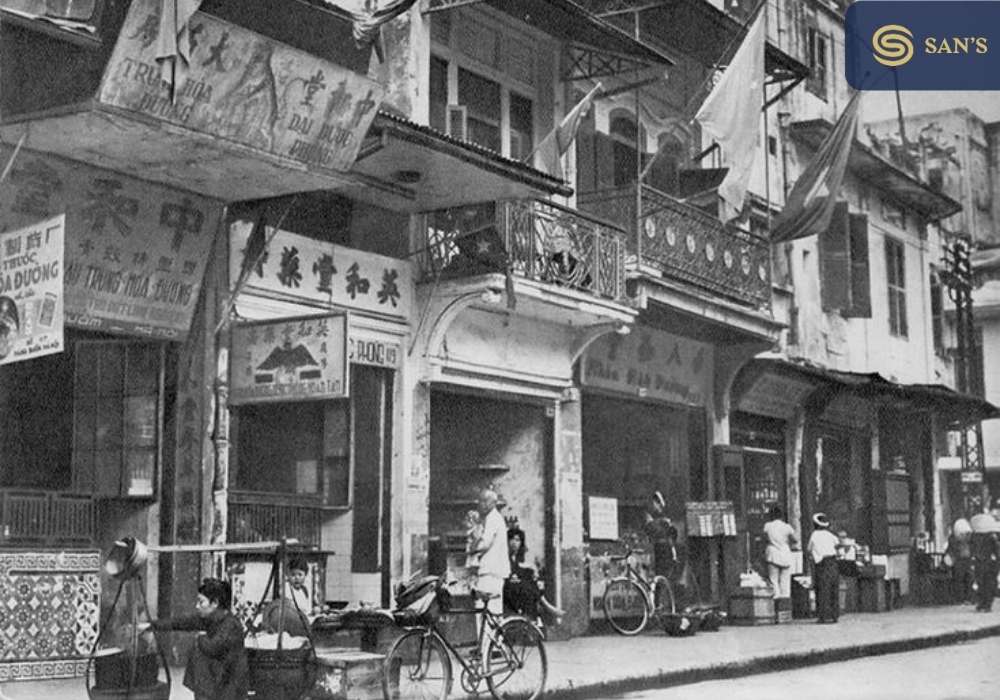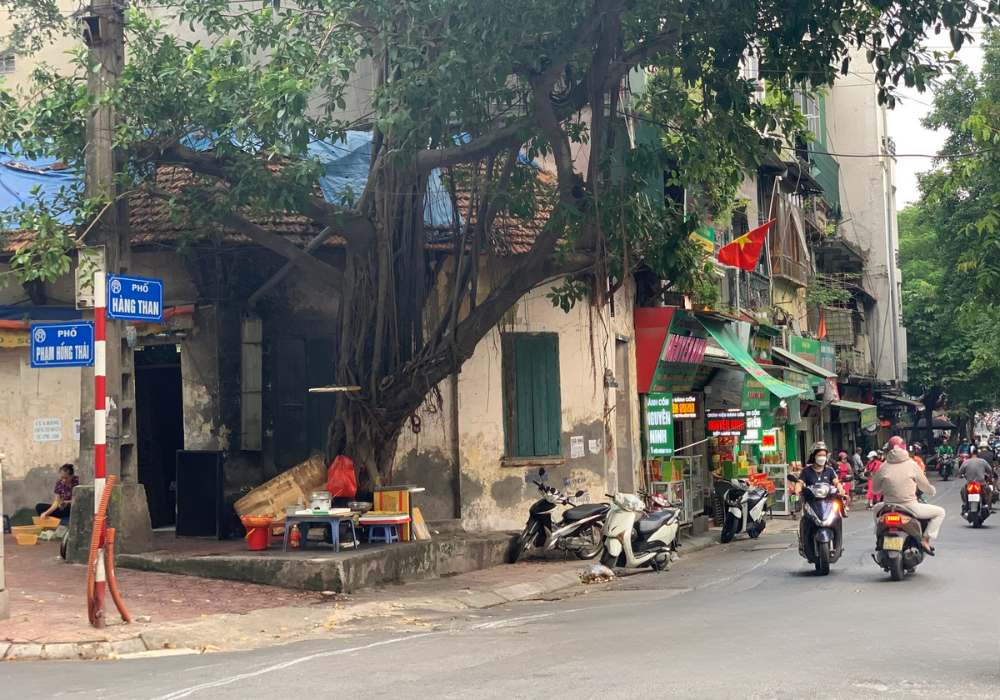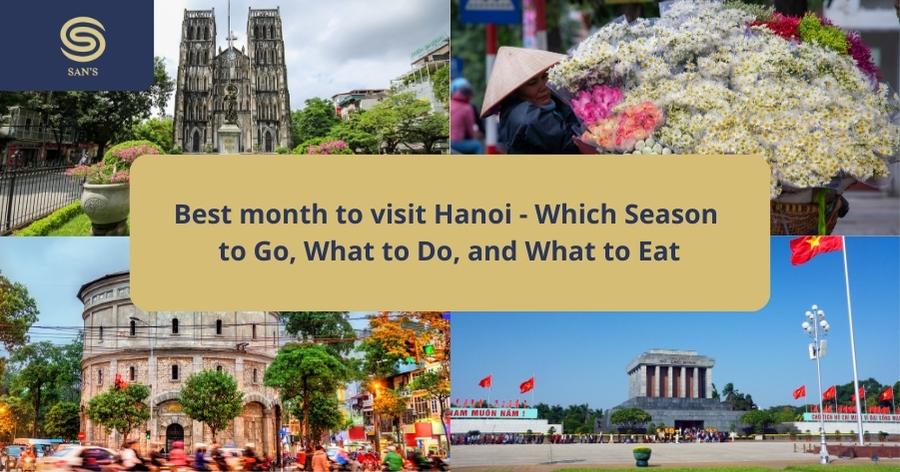Hanoi, the heart of Vietnam, is a symphony of age-old traditions, mesmerizing landscapes, and vivacious urban life. With a history that stretches over a millennium, this ancient capital has witnessed epochs of change, from royal dynasties and colonial rules to revolutions and rapid modernization. Every corner tells a story, and each alleyway whispers ancient tales. Among the city’s intricate web of streets, Hang Than Street stands out as a beacon of Hanoi’s dynamic culture and history.
-

Hanoi Old Quarter in the past
Located in the Old Quarter, Hang Than Street is more than just a path that leads from one point to another; it’s a testament to Hanoi’s indomitable spirit. A place where the old embraces the new, where aromatic street foods blend seamlessly with boutique cafes, and where history lives alongside the buzz of modern commerce. In this article, we embark on a journey down Hang Than Street, uncovering its secrets, relishing its flavors, and understanding why it remains one of the most significant streets in the heart of Hanoi.
Historical Significance of Hang Than Street
Hang Than Street, etched in the cultural fabric of Hanoi, boasts a tale that weaves through centuries. Its story, much like Hanoi itself, is one of resilience, evolution, and a deep-seated reverence for the past.
The origins of Hang Than can be traced back to ancient times when it was one of the 36 specialized streets of Hanoi’s Old Quarter, a hub for skilled craftsmen and traders. Historically, the street was known for the sale of ceremonial cakes and goods, particularly during the Tet Nguyen Tieu Festival. Over time, its commercial focus might have shifted, but the legacy of its bygone traders still lingers in its name, with “Hang” meaning merchandise and “Than” referring to coal, a nod to its coal trading past.
-

Hang Than Street in the past
The French colonial era, a transformative period for much of Vietnam, left its indelible mark on Hang Than Street as well. The architectural styles from this time present a fusion of Vietnamese and French elements, reflecting the intersection of two worlds. The shophouses, with their tall windows and ornate balconies, tell tales of colonial influences while still retaining the essence of Vietnamese design.
Numerous landmarks pepper the street, echoing its historical significance. One such place is the Quan De Temple, an ancient structure dedicated to the legendary General Guang Yu of the Three Kingdoms period. Another is the Ba Da Pagoda, which not only stands as one of the oldest temples in Hanoi but also serves as a silent observer to the ebb and flow of life on Hang Than through the ages.
In essence, Hang Than Street is more than just a thoroughfare in Hanoi’s bustling Old Quarter. It’s a living museum, a testament to Hanoi’s ever-evolving narrative, and a reflection of its rich tapestry of history.
Hang Than Street Today: A Blend of Old and New
Stepping onto Hang Than Street today, one is immediately captivated by its electric atmosphere, a unique blend of yesteryears and the contemporary. This street, ensconced in the heart of Hanoi’s Old Quarter, pulsates with life, reflecting the city’s seamless melding of the ancient with the avant-garde.
A stroll along Hang Than unveils a fascinating tableau of its current-day ambiance. Elderly residents perch on low stools, sipping their morning tea, while young entrepreneurs zip by on scooters, heading to chic boutiques and modern workspaces. Street vendors call out their wares, their voices intertwining with the soft melodies emanating from a nearby contemporary café. The aroma of traditional pho mingles effortlessly with the scent of freshly brewed cappuccinos, painting a vivid picture of a street in harmony with both its roots and its present.
-

Hang Than Street now
Architecturally, Hang Than is a visual delight. The storied façades of ancient shophouses stand shoulder to shoulder with sleek modern establishments. These timeworn structures, with their faded paint and ornate woodwork, narrate tales of a time long gone. Yet, interspersed between them are newer buildings—art galleries, boutique hotels, and trendy cafes—that echo a different, more recent story of Hanoi’s urban renaissance.
Perhaps what’s most enchanting about Hang Than Street is its role as a confluence of tradition and modernity. On one end, you might find a centuries-old temple, its walls echoing with chants and prayers, while just a stone’s throw away, a hipster bar might be hosting an indie music night. It’s not uncommon to spot a traditional puppetry show setting up just a few meters from a state-of-the-art cinema screen.
Hang Than Street, in its essence, epitomizes Hanoi’s spirit today. It’s a place where the past is not only remembered but celebrated, and where the future is embraced with open arms. In the heart of the city, Hang Than stands as a testament to Hanoi’s timeless allure, gracefully balancing the weight of history with the promise of tomorrow.
Tips for Visitors
Navigating the vibrant and bustling Hang Than Street can be both an exciting and overwhelming experience for first-time visitors. Here’s a handy guide to ensure you make the most of your visit while navigating like a local:
- Best Time of the Day to Visit:
- Morning (6 am – 9 am): Experience the street coming alive. This is when you can witness the locals setting up their shops, enjoy a serene walk, and relish a traditional Vietnamese breakfast.
- Late Afternoon to Early Evening (4 pm – 7 pm): As the sun sets, the street gets imbued with a golden hue. The markets are in full swing, and the eateries come alive with the tantalizing aroma of evening snacks and meals.
- How to Get There: Transportation Options and Routes:
- Walking: If you’re staying within the Old Quarter, the best way to explore is on foot. This allows you to fully immerse in the sights and sounds.
- Cyclo: A traditional mode of transportation, a cyclo ride offers a leisurely and scenic tour of the street and its surroundings.
- Taxi or Ride-sharing: Always ensure the taxi meter is on or agree on a price beforehand. Apps like Grab are also popular in Hanoi and can be a more predictable pricing option.
- Public Buses: Hanoi’s bus system is extensive and cheap. Bus #9, for example, has a stop near Hang Than Street. However, it might be challenging for those not familiar with the routes or the language.
-

Hang Than Street
Hang Than Street is not just a pathway in Hanoi but a vivid representation of the city’s past meeting its present. It epitomizes Hanoi’s spirit, blending ancient tales with modern rhythms. Every corner, aroma, and sound on this street paints an authentic picture of the city’s essence. While words can describe its allure, nothing compares to experiencing it personally. For anyone seeking the heartbeat of Hanoi, Hang Than is a journey waiting to unfold. Embark on it, and let Hanoi’s narrative come alive beneath your feet.
FAQs about Hang Than Street, Hanoi
- What is Hang Than Street famous for?
- Historically, Hang Than Street was known for trading ceremonial cakes and goods. Today, it’s recognized for its unique blend of traditional and modern establishments, from food stalls to boutique shops.
- Is it safe to visit Hang Than Street at night?
- Yes, like most parts of Hanoi’s Old Quarter, Hang Than Street is generally safe at night. However, always exercise general safety precautions and be aware of your surroundings.
- Are there any special events or festivals on Hang Than Street?
- Hang Than Street is bustling during traditional Vietnamese festivals, especially the Tet Nguyen Tieu Festival when ceremonial goods are in high demand.
- How long should I spend exploring Hang Than Street?
- You can spend anywhere from a couple of hours to a full day, depending on your interest. From shopping to dining and exploring historical sites, there’s plenty to see and do.
- Are there guided tours available for Hang Than Street?
- While there are many guided tours for Hanoi’s Old Quarter, you might want to check specifically for tours focusing on Hang Than or customize a private tour to include it.
- What unique souvenirs can I find on Hang Than Street?
- From traditional Vietnamese handicrafts to modern boutique offerings, you’ll find a variety of unique souvenirs. Look out for artisanal products, traditional fabrics, and local delicacies.
- Is it vegetarian-friendly?
- Yes, like most of Hanoi, you can find vegetarian and even vegan options in many eateries on Hang Than Street. Always good to ask or check menus.
- How do I get to Hang Than Street using public transport?
- Hanoi’s bus system is extensive, and several routes stop near or at Hang Than. However, if you’re unfamiliar with the language or routes, using ride-sharing apps or taxis might be more convenient.
- Is Hang Than Street suitable for children or elderly visitors?
- Absolutely! However, like many streets in the Old Quarter, it can be bustling, so ensure children are supervised, and elderly visitors are comfortable with walking.
- Are there any dress codes for visiting religious sites on Hang Than Street?
- Yes, when visiting temples or pagodas, it’s recommended to dress modestly, covering shoulders and knees. It’s always respectful to follow local customs.
These FAQs aim to provide visitors with a quick understanding of Hang Than Street and ensure a smooth and enriching experience during their visit.





